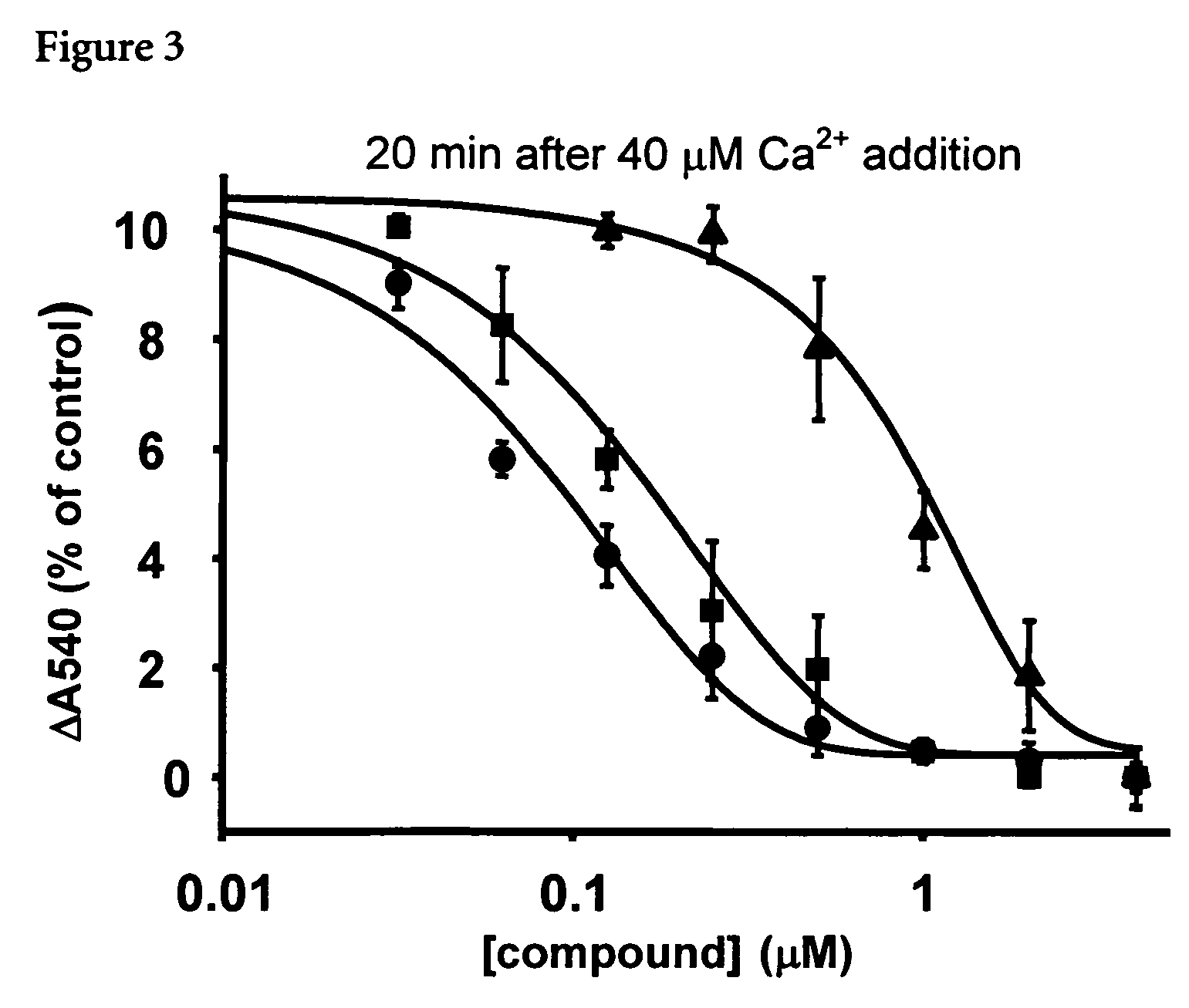Mitochrondrial permeability transition pore affinity labels and modulators
a technology of mitochrondrial permeability and affinity labels, applied in the field of mitochrondrial permeability transition pore affinity labels and modulators, can solve problems such as preventing progress in the field
- Summary
- Abstract
- Description
- Claims
- Application Information
AI Technical Summary
Problems solved by technology
Method used
Image
Examples
example 1
Screening Assay
[0062] In an attempt to identify new inhibitors of the MPTP, a compound library was screened using Ca2+-induced swelling (in the presence Pi) of rat liver mitochondria energized with succinate (in the presence of 2 μM rotenone) as functional assay.
[0063] Liver and brain mitochondria were prepared from male Albino RoRo rats or MoRo mice (BRL, Füllinsdorf, Switzerland). For swelling experiments, liver mitochondria were isolated by differential centrifugation according to standard procedures (Costantini, P., Petronilli, V., Colonna, R. & Bernardi, P. (1995) Toxicology 99, 77-88). The mitochondrial pellet was resuspended in 250 mM sucrose buffered to pH 7.4 with 10 mM Tris HCl and kept in ice until use. Brain mitochondria from rat and mouse were obtained using a Percoll gradient according to the method described in (Sims, N. R. (1990) J. Neurochem. 55, 698-707). For affinity labeling experiments in liver mitochondria, organelles from this tissue were also isolated on a ...
example 2
Spiro[cyclopentane-1,5′-[5H]dibenzo[a,d]cyclohepten]-2-one,10′,11′-dihydro-3-methylene-
[0067]
[0068] Spiro[cyclopentane-1,5′-[5H]dibenzo[a,d]cyclohepten]-2-one,10′,11′-dihydro- (0.3 g, 1.14 mmol), pyrrolidine hydrochloride (0.146 g, 1.37 mmol) and paraformaldehyde (0.1 g, 4.42 mmol) were dissolved in DMF (1 ml). The reaction mixture was immersed in a 80° C. oil bath, stirred for 2.5 hours under argon, and then the solvent was evaporated under high vacuum. The residue was taken in MeCl2 and 1N NaOH was added. Aqueous phase was extracted with MeCl2 and the combined organic phases were washed with water, dried with Na2SO4, concentrated in vacuo. The residue was dissolved in 4 ml CH2Cl2 and stirred at room temperature for 20 minutes in the presence of SiO2 (1.3 g). After filtration, SiO2 was washed with CH2Cl2. Filtrate was concentrated and the residue was chromatographed over silica gel (hexane-ethylacetate 48:02) to provide spiro[cyclopentane-1,5′-[5H]dibenzo[a,d]cyclohepten]-2-one,10...
example 3
Spiro[cyclopentane-1,5′-[5H]dibenzo[a,d]cyclohepten]-2-one,10′,11′-t2-10′,11′-dihydro-3-methylene-
[0069]
[0070] Spiro[cyclopentane-1,5′-[5H]dibenzo[a,d]cyclohepten]-2-one,10′,11′-t2-10′,11′-dihydro- (2.2 Ci), pyrrolidine hydrochloride (3.5 mg, 0.033 mmol) and paraformaldehyde (3 mg, 0.1 mmol) were dissolved in DMF (0.1 ml). The reaction mixture was immersed in a 80° C. oil bath, stirred for 2.5 hours under argon, and then the solvent was evaporated under high vacuum. The residue was taken in MeCl2 and 1N NaOH was added. Aqueous phase was extracted with MeCl2 and the combined organic phases were washed with water, dried with Na2SO4, concentrated in vacuo. The residue was dissolved in 4 ml CH2Cl2 and stirred at room temperature for 2 hours in the presence of SiO2 (200 mg). After filtration, filtrate was chromatographed on 1 g of Lichroprep Si60 25-40 μm (hexane-ethylacetate 48:02). The total activity of the purified product was 1.376 Ci and the specific activity as determined by mass ...
PUM
| Property | Measurement | Unit |
|---|---|---|
| pH | aaaaa | aaaaa |
| pH | aaaaa | aaaaa |
| volume | aaaaa | aaaaa |
Abstract
Description
Claims
Application Information
 Login to View More
Login to View More - R&D
- Intellectual Property
- Life Sciences
- Materials
- Tech Scout
- Unparalleled Data Quality
- Higher Quality Content
- 60% Fewer Hallucinations
Browse by: Latest US Patents, China's latest patents, Technical Efficacy Thesaurus, Application Domain, Technology Topic, Popular Technical Reports.
© 2025 PatSnap. All rights reserved.Legal|Privacy policy|Modern Slavery Act Transparency Statement|Sitemap|About US| Contact US: help@patsnap.com



